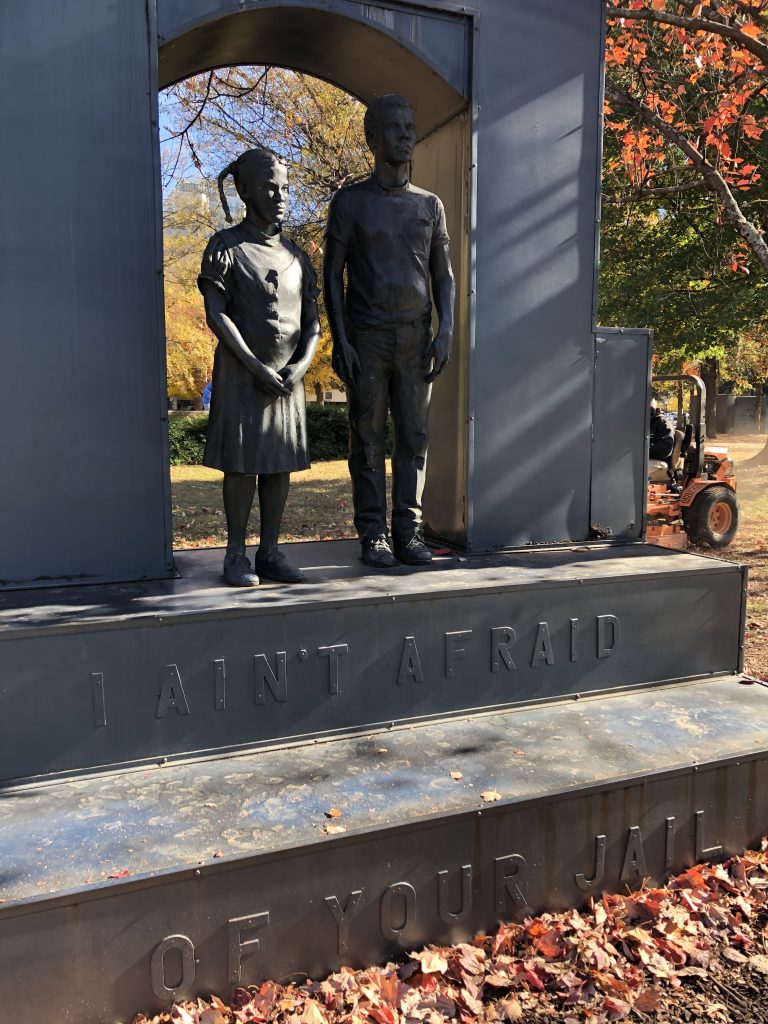Blog by: Alex Barr ’22, Horacio Garcia-Rojas ’23 and Drew Johannes ’23

As we rode into Birmingham, Alabama, we could feel a bit of excitement in a strange way. Having known some of the stories of the Civil Rights Movement and Birmingham’s significance, we held a feeling of reverence. We didn’t know whether to smile or not in pictures because of where we stood and the history that is attributed to the city.
We visited the 16th Street Baptist Church, the site of the infamous bombing in September of 1963. Four young Black girls lost their lives at this church at the hands of members of Birmingham’s local Ku Klux Klan (KKK). Being in the church and hearing the stories first-hand was deeply moving. The church was beautiful. The architecture on the outside was immaculate, with stunning stained-glass windows on all sides of the church, and a massive skylight piece. It seemed like the last place that a 50-pound dynamite bomb should explode. On the same side that the bomb went off, a large stained-glass mural of Jesus stands. Being on the same side as the bomb it should have been destroyed, but only the face of Jesus was damaged, leaving the rest of the mural intact. The tour guide explained that many believed that this happened because “not even God could look at what happened that day in 1963,” and we’d like to believe that as well.
After our tour of the church, we went to the Birmingham Civil Rights Institute. The exhibits there were fantastic and representative of the history that not only happened in Birmingham, but throughout the rest of the movement across the country as well. The importance of the Church as being the center of the Civil Rights Movement was represented well — it had not been exhibited as well before as we saw in the cultural and educational research center. The tour began with a video that set the mood and displayed on the differences on how white and Black people were treated. Once the projector rolled up to reveal the entrance of the exhibit, the journey through the long museum began.
Some exhibits that really stuck out include the comparision of the Black and white classrooms. The white classroom looked clean and mint. The desks looked decent and on the walls had pictures hanging of respected white presidents. The black classroom looked second-hand. Everything appeared as wood and dingy. On the walls hung portraits of Frederick Douglas and Abraham Lincoln. The differences were very clear and put into perspective on who was favorited in that point of history.
As we arrived in Aniston, Alabama, it felt like we went back in time to see the development of the Civil Rights Movement. We witnessed an uncanny resemblance to areas that are “frozen in time” with almost perfect preservation of historic monuments. Moving to the location where the first white individual was convicted for a hate crime, it was moving toward the right direction considering that Emmitt Till’s case had a bias jury out the bat. The historic marker proved that the United States is progressing and improving race relationships across the board. Local elections proved the progression of race relations and improving American democracy by electing Birmingham’s first Black mayor. In addition, it was interesting that the city preserved monument sights where the Freedom Riders had an impact on the town. We appreciated that the National Park Service hosts tours to make sure the preservation of the Bus Monument to ensure the historical and educational preservation to offer the opportunity for individuals to listen to stories, and admire the scenery of the antique town.
